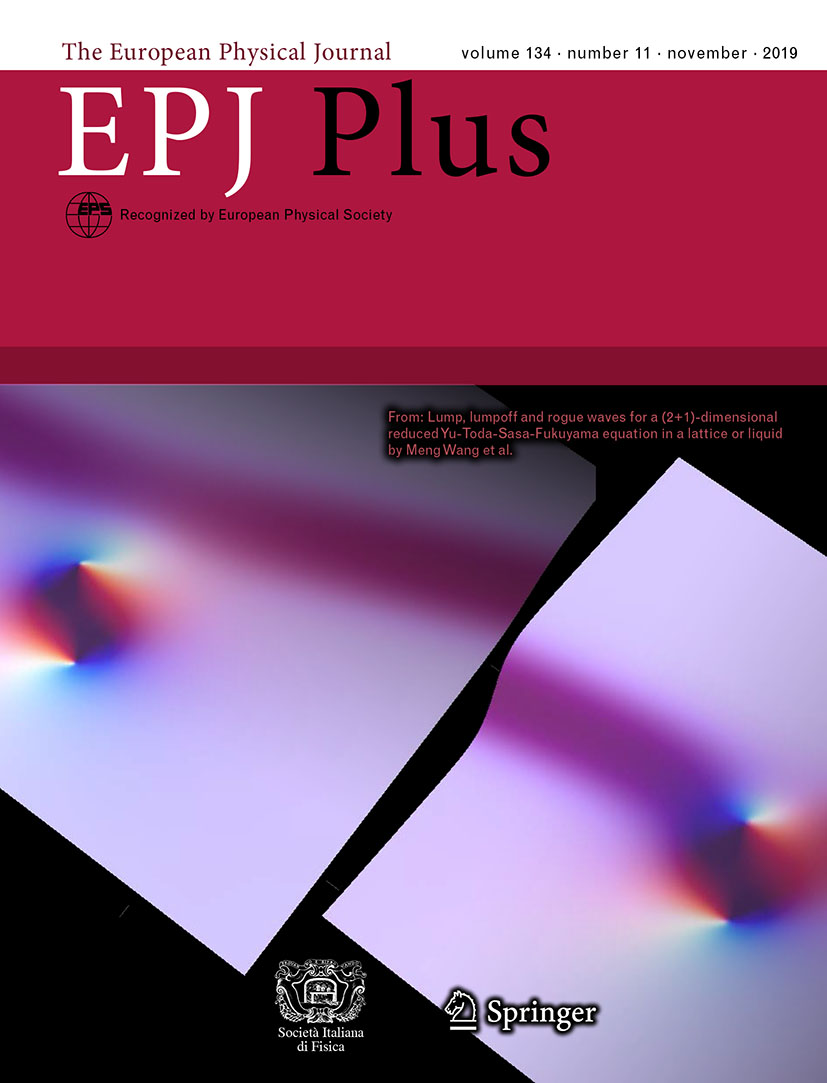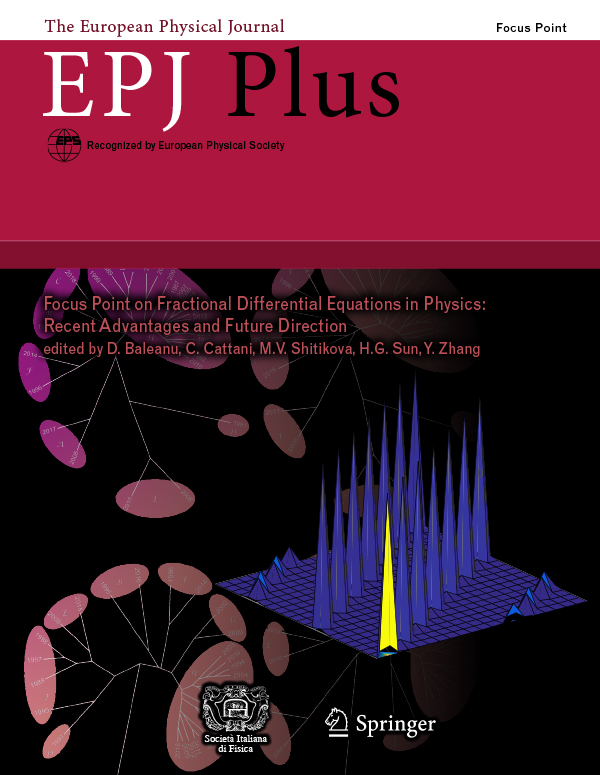News / Highlights / Colloquium
EPJ Plus Focus Point on Solitons, Integrability, Nonlinear Waves: Theory and Applications
- Details
- Published on 15 January 2021

Nonlinear waves have long been at the research focus of both physicists and mathematicians, in diverse settings ranging from electromagnetic waves in nonlinear optics to matter waves in Bose-Einstein condensates, from Langmuir waves in plasma to internal and rogue waves in hydrodynamics. The study of physical phenomena by means of mathematical models often leads to nonlinear evolution equations known as integrable systems. One of the distinguished features of integrable systems is that they admit soliton solutions, i.e., stable, localized traveling waves which preserve their shape and velocity in the interaction. Other fundamental properties are their universal nature, and the fact that they can be effectively linearized, e.g., via the inverse scattering transform, or reduced to appropriate Riemann-Hilbert problems. Moreover, solutions can often be derived by the Zakharov-Shabat dressing method, by Backlund or Darboux transformations, or by Hirota’s method. Prototypical examples of such integrable equations in 1+1 dimensions are the nonlinear Schrödinger equation and its multicomponent generalizations, the sine-Gordon equation, the Korteweg-de Vries and the modified KdV equations, etc. In 2+1 dimensions the most notable examples are the Kadomtsev-Petviashvili (KP) equations, and the Davey-Stewartson equations. The aim of this special issue is to present the latest developments in the theory of nonlinear waves and integrable systems, and their various applications.
EPJ Plus Highlight - Understanding electron transport in graphene nanoribbons
- Details
- Published on 10 September 2020

New understanding of the electrical properties of graphene nanoribbons (GRBs), when bounded with aromatic molecules, could have significant benefits in the development of chemosensors and personalised medicine.
Graphene is a modern wonder material possessing unique properties of strength, flexibility and conductivity whilst being abundant and remarkably cheap to produce, lending it to a multitude of useful applications – especially true when these 2D atom-thick sheets of carbon are split into narrow strips known as Graphene Nanoribbons (GNRs). New research published in EPJ Plus, authored by Kristiāns Čerņevičs, Michele Pizzochero, and Oleg V. Yazyev, École Polytechnique Fédérale de Lausanne (EPFL), Lausanne, Switzerland, aims to better understand the electron transport properties of GNRs and how they are affected by bonding with aromatics. This is a key step in designing technology such chemosensors.
EPJ Plus Focus Point on Nanotechnology, Nanomaterials and Interfaces
- Details
- Published on 24 July 2020

The Special Issue contains the articles which were presented at the International research and practice conference “Nanotechnology and Nanomaterials” (NANO-2018), which was organized by the Institute of Physics of NAS of Ukraine with the participation of the Yuriy Fedkovych Chernivtsi National University (Ukraine), University of Tartu (Estonia), University of Turin (Italy), Pierre and Marie Curie University – Paris 6 (France).
The Special Issue gathered high-level articles at the forefront of nanoscience research which is devoted to: the optical absorption by a nanosystem with dielectric quantum dots; the fabrication of crystalline Bi2TeO5 - Bi4Si3O12 - SiO2 nanocomposite; the existence of both size and “even-odd” effects for the lifetime of carbyne-based nanodevices consisting of two graphene sheets connected by a carbyne chain; the adsorption properties of the silica-titanium mixed oxide; the adsorption properties and application perspectives of BSA films as sensitive coatings for gas sensors; the properties of MgFe2O4; to the problem of band broadening of SPR; the structural studies concerning the formation of self-assembled indium deposited nanostructures on the (100) surface of In4Se3 layered semiconductor and the possibility of constructing the general dynamic properties of a conduction electron injected into graphene in the rectangular lattice approximation.
The Guest Editor, Olena Fesenko, hopes that this collection provides a quick overview on recent trends in this emerging field of research.
EPJ Plus Highlight - Mathematical curves predict evolution in Covid-19 spread
- Details
- Published on 23 April 2020

With the right approach, statistics can be used to reliably track the growth and fall in daily new cases of Covid-19 in China, raising hopes that similar approaches could more accurately predict the spread of the virus in other nations.
Efforts to contain the spread of the Covid-19 pandemic are now the top priority of governments across the globe. As they make these life-saving decisions, it is particularly crucial for policymakers to accurately predict how the spread of the virus will change over time. Through research published in EPJ Plus, Ignazio Ciufolini at the University of Salento, and Antonio Paolozzi at Sapienza University of Rome, identify a clear mathematical trend in the evolution of daily new cases and death numbers in China, and use the same curve to predict how a similar slowdown will unfold in Italy.
EPJ Plus Highlight - Models explain changes in cooking meat
- Details
- Published on 01 April 2020

By treating meat as a network of flexible polymers surrounded by flowing moisture, computer models can accurately predict how much it will shrink when cooked.
Meat is no ordinary solid. Made up of complex networks of moisture-saturated proteins, it displays some intriguing physical properties when it is cooked. Several studies in the past have attempted to recreate this behaviour in computer simulations, but because this demands so much computing power, they have only achieved simplified, one-dimensional recreations of the process, which aren’t particularly accurate. In new research published in EPJ Plus, mathematicians led by Dr Hala Nelson at James Madison University show that by modelling meat as a fluid-saturated matrix of elastic proteins, which are deformed as the fluid moves, cooking behaviours can be simulated more precisely.
EPJ Plus Focus Point: Scientific Research in Conservation Science
- Details
- Published on 17 January 2020

This special issue is related to the 3rd edition of the International Conference on Innovation in Art Research and Technology (inArt 2018) held in Parma (Italy). The Focus Point includes 20 excellent examples of the research works presented at the Conference. In particular, attention is focused on: non-invasive investigation techniques; new materials for restoration in compliance with the artifacts and the environment; products for the prevention of corrosion and of degradation; self-cleaning materials. The articles are devoted to the study of many different art objects and materials, including paintings (pigments, dyes, binders), textiles, manuscripts, buildings as well as building materials, metals, glasses, gems, bones and ivory. The analyzed objects span a huge time interval, ranging from antiquity (ancient Egypt) to contemporary art. Many different techniques are involved: spectroscopy in the different ranges of the electromagnetic spectrum (from infrared to X-rays); visible and electron microscopy; multispectral imaging; three-dimensional reconstruction, using instruments as handheld spectrometers, neutron sources or particle accelerators. Data treatment is also discussed, from databases to data integration and decision tools.
EPJ Plus Focus Point: Past and Present: Recent Advances in the Investigation of Ancient Materials by Means of Scientific Instrumental Techniques
- Details
- Published on 12 December 2019

This Focus Point introduces selected papers from the contributions presented at the 10th Congress of Italian Association of Archaeometry (AIAr) held in Turin (Italy) in February 2018, where a large parterre of Italian as well as International researchers shared their experiences on new and more consolidated analytical approaches on archaeological and artistic materials.
Different topics were addressed in the realm of cultural heritage, from characterisation and diagnostics to bioarchaeology and man-environment interaction. A strong focus was put on the comparison between non-invasive/non-destructive and micro-invasive methods in the study of different categories of objects, evaluating the pros and cons of each approach. Also a growing interest, accompanied by increasing technological skills, was registered for monitoring of environmental conditions to which the archaeological and artistic patrimony is subjected.
EPJ Plus Focus Point: Fractional Differential Equations in Physics: Recent Advantages and Future Direction
- Details
- Published on 20 November 2019

The Focus Point on “Fractional Differential Equations in Physics: Recent Advantages and Future Direction” presents some of the multiple open research directions within the dynamical field of fractional calculus and its applications. Traditional viewpoints together with fractional calculus models and techniques are used to provide the readers with a full picture of how dynamic and useful fractional calculus ideas are in treating the dynamics of complex phenomena arising from science and engineering. We hope that the research articles of this Focus Point will motivate young researchers to apply their original ideas for solving the multiple open problems within fractional calculus.
EPJ Plus Highlight - Science reveals improvements in Roman building techniques
- Details
- Published on 24 October 2019

Carole Raddato from Frankfurt, Germany [CC BY-SA 2.0 (https://creativecommons.org/ licenses/by-sa/2.0)]
A variety of scientific techniques have been combined to highlight improvements in the technologies employed by the Romans in successive modifications to the Atrium Vestae in Rome.
The Romans were some of the most sophisticated builders of the ancient world. Over the centuries, they adopted an increasingly advanced set of materials and technologies to create their famous structures. To distinguish the time periods over which these improvements took place, historians and archaeologists typically measure the colours, shapes and consistencies of the bricks and mortar used by the Romans, along with historical sources. In new research published in EPJ Plus, Francesca Rosi and colleagues at the Italian National Research Council improved on these techniques through scientific analysis of the materials used to build the Roman Forum’s Atrium Vestae. They found that successive phases of modification to the building saw improvements including higher quality raw materials, higher brick firing temperatures, and better ratios between carbonate and silicate building materials.
EPJ Plus Highlight - Science puts historical claims to the test
- Details
- Published on 06 September 2019

The latest analytical techniques available to scientists can confirm the validity of historical sources in some cases, and suggest a need for reconsideration in others
As any historian will tell you, we can rarely take the claims made by our ancestors at face value. The authenticity of many of the artefacts which shape our understanding of the past have been hotly debated for centuries, with little consensus amongst researchers. Now, many of these disputes are being resolved through scientific research, including two studies recently published in EPJ Plus. The first of these, led by Diego Armando Badillo-Sanchez at the University of Évora in Portugal, analysed an artefact named ‘Francisco Pizarro’s Banner of Arms’ – believed to have been carried by the Spanish conquistador during his conquest of the Inca Empire in the 16th century. The second team, headed by Armida Sodo at Roma Tre University in Italy, investigated a colour print of Charlemagne – the medieval ruler who united much of Western Europe – assumed to be from the 16th century.







